Platform screen doors
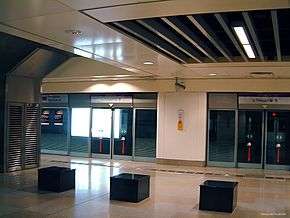
Platform screen doors (PSDs) and platform edge doors (PEDs) at train or subway stations screen the platform from the train. They are a relatively new addition to many metro systems around the world, some having been retrofitted to established systems. They are widely used in newer Asian and European metro systems.
History
The first stations in the world with platform screen doors are ten stations in the Saint Petersburg Metro's Line 2 that opened between 1961 and 1972. The platform "doors" are actually openings in the station wall, which support the ceiling of the platform. The track tunnels adjoining the ten stations' island platforms were built with tunnel boring machines (TBMs), and the island platforms were actually located in a separate vault between the two track tunnels. Usually, TBMs bore the deep-level tunnels between stations, while the station vaults are dug out manually and contain both the tracks and the platform. However, in the case of the Saint Petersburg Metro, the TBMs bored a pair of continuous tunnels that passed through ten stations, and the stations themselves were built in vaults that only contained the platform (with small openings on the sides of the vault, in order for passengers to access the trains in the tunnels). These openings were covered with steel doors in order to prevent people from falling into the gaps between the walls.[1]
In 1987, the Singapore MRT was the first system in the world to install glass PSDs based on safety reasons, rather than based on architectural constraints.[1]
Types
Although the terms are often used interchangeably, platform screen doors can refer to both full-height and half-height barriers. Full height platform screen doors are total barriers between the station floor and ceiling, while the half-height platform screen doors are referred to as platform edge doors, as they do not reach the ceiling and thus do not create a total barrier. The half-screen doors are usually only half of the height of the full-screen doors, but they sometimes reach to the height of the train. These two types of platform screen doors are presently the main types in the world.
Platform screen doors
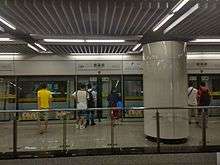
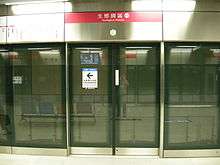
These doors help to:
- Prevent accidental falls off the platform onto the lower track area, suicide attempts and homicides by pushing.
- Prevent or reduce wind felt by the passengers caused by the piston effect which could in some circumstances make people fall over
- Reduce the risk of accidents, especially from service trains passing through the station at high speeds.
- Improve climate control within the station (heating, ventilation, and air conditioning are more effective when the station is physically isolated from the tunnel).
- Improve security — access to the tracks and tunnels is restricted.
- Lower costs — eliminate the need for motormen or conductors when used in conjunction with Automatic Train Operation, thereby reducing manpower costs.
- Prevent litter build up on the track, which can be a fire risk.
- Improve the sound quality of platform announcements, as background noise from the tunnels and trains that are entering or exiting is reduced.
Their primary disadvantage is their cost; installing a system typically costs several million USD per station. When used to retrofit older systems, they limit the kind of rolling stock that may be used on a line, as train doors must have exactly the same spacing as the platform doors; this results in additional costs due to depot upgrades and otherwise unnecessary purchases of rolling stock. They also impede natural ventilation, increasing climate control costs.
The doors also pose their own safety risks. The primary risk is that people may be trapped between the platform doors and the train carriage, and be subsequently crushed when the train begins to move (see Accidents). Cases of this happening are rare, and may depend upon door design.
Automatic platform gate

Half-height platform screen doors, or automatic platform gates, are chest-height sliding doors at the edge of railway platforms to prevent passengers from falling off the platform edge onto the railway tracks. Like full-height platform screen doors, these platform gates slide open or close simultaneously with the train doors.
Half-height platform gates are cheaper to install than platform screen doors, which require more metallic framework for support. Some railway operators may therefore prefer such an option to improve safety at railway platforms and, at the same time, keep costs low and non-air-conditioned platforms naturally ventilated. However, these gates are less effective than full platform screen doors in preventing people from intentionally jumping onto the tracks.
These gates were first in practical use by the Hong Kong MTR on the Disneyland Resort Line for their open-air station design. The later design by other manufacturers, such as Manusa or Gilgen Door Systems AG, have their gates higher than the ones installed on the Disneyland Resort Line.
A few examples include:
- Beijing Subway
- Paris Métro
- Mass Rapid Transit (Singapore)
- MTR (Hong Kong)
- Fukuoka City Subway
- Osaka Municipal Subway
- Tokyo Monorail, Tokyo Metro, and Toei Metro
- Taipei Metro
Use
Australia
The North West Rail Link in Sydney will open in 2019 and will be the first fully automated rapid transit rail system in Australia. The new stations will be equipped with full height platform screen doors on underground platforms and half height on at grade/elevated platforms. The existing 5 stations on the Epping to Chatswood railway line will be upgraded to rapid transit standard, all featuring half height platform screen doors.[2]
Brazil
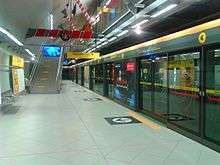
The São Paulo Metro has nine stations with platform screen doors: Sacomã station (Line 2 - Green) opened on 30 January 2010 with this feature. On 25 May 2010, Faria Lima and Paulista stations (Line 4 - Yellow) opened featuring PSDs; on 21 August 2010, Vila Prudente Station was opened with PSDs and on 21 September 2010, Tamanduateí Station was also opened with PSDs. Stations Butantã, Pinheiros, República, and Luz of Line 4 - Yellow, opened in 2011 with PSDs. All the future stations of the system will be inaugurated with PSDs. They are planned to be installed in the old stations as well.[3]
Canada
Screen doors are in use at all three LINK Train stations and the Union and Pearson Union Pearson Express stations at Toronto Pearson International Airport in Mississauga, Ontario.
China
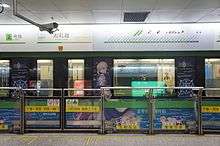
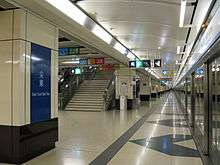
All Chinese metro systems have platform screen doors installed on most of their lines. All stations built after the mid 2000s have some form of platform barrier. Only the Shanghai Metro, Beijing Subway, Guangzhou Metro, Nanjing Metro and Wuhan Metro have stations without the platform screen doors on their early lines. In addition, many BRT systems such as the Guangzhou Bus Rapid Transit are also equipped with platform screen doors.
Hong Kong
In 1998, the Tung Chung Line and Airport Express saw the earliest operations of platform screen doors in Hong Kong. Since then, the MTR Corporation began to retrofit 2,960 pairs of screen doors at all the underground stations of the MTR network, the first in the world to retrofit PSDs on a transit system already in operation. The project was completed in October 2005.[4] The remaining eight at-grade or elevated stations of the former MTR network (i.e. excluding former KCR stations) were retrofitted with automatic platform gates in 2011, and similar works are now ongoing at all stations on the MTR's Ma On Shan Line, a former KCR line.
Platform screen doors were also installed on all platforms of the West Rail Line, then built by the Kowloon-Canton Railway Corporation (KCRC) before the MTR-KCR merger.
The installation of platform screen doors in Hong Kong has been effective in reducing railway injuries and service disruptions.[5]
The longest set of platform screen doors in the world can be found in East Tsim Sha Tsui Station.[6] A reduction of train length from 12 to 7 cars following the construction of Kowloon Southern Link caused many of the screen doors to be put out of service, although the trains are presently being lengthened again to 8 cars.
The platform screen doors presently in service in the MTR were supplied by the Swiss manufacturer Kaba Gilgen, the Japanese Nabtesco Corporation, as well as Faiveley Transport. The last stations in Hong Kong without platform screen doors or gates are all found on the East Rail Line and Ma On Shan Line, both former KCR lines not part of the MTR APG retrofitting programmes. However, these remaining stations are all being retrofitted by Kaba as part of the Sha Tin to Central Link project.[7]
Apart from the MTR, all stations on the Hong Kong International Airport Automated People Mover are equipped with platform screen doors.
Denmark
The Copenhagen Metro uses Westinghouse[8] and Faiveley platform screen doors on its underground stations' platforms.
Finland
The Helsinki Metro is currently conducting a trial run with Faiveley automatic platform gates installed on a single platform at Vuosaari metro station during phase one of the project. The doors, which are part of the Siemens metro automation project, were built in 2012. Phase 2 of the project has been delayed due to metro automation technical and safety related testings.[9]
France
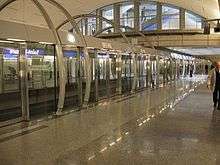
Paris Métro's line 14 from Saint-Lazare to Bibliothèque François Mitterrand was inaugurated with Faiveley platform screen doors. The new station Olympiades opened with platform screen doors in June 2007. Line 1 has been retrofitted with platform screen doors, for full driverless automation effective in 2012. Some stations on Line 13 have had platform edge doors since 2010 due to overcrowding, after tests were conducted in 2006.
In addition, all lines of the VAL automated subway system are also equipped with platform screen doors at every station. Those include Toulouse, Rennes and Lille subways, as well as the CDGVAL and Orlyval airport shuttles.
The D line in Lyon, which is equipped with fully automated trains, does not have platform screen doors but identifies obstructions by infrared detectors upon the tracks. A similar system is employed by the metro system in Nuremberg, Germany.
Germany
People movers at Frankfurt International Airport and Düsseldorf International Airport are equipped with platform screen doors, as well as the suspended monorail in Dortmund, called H-Bahn.
India
Platform screen doors are used in all the platforms on Delhi Airport Metro Express of the Delhi Metro line which links New Delhi Metro Station and Dwarka Sector 21 with the Indira Gandhi International Airport.[10] Platform screen doors will also be installed in five busiest stations of Line 2 by November 2015 and all stations of upcoming Line 7 and Line 8 of Delhi Metro.[11] There are also plans to install platform screen doors on Line 1 and Line 2 of the Kolkata Metro.[12] Chennai Metro will have platform screen doors installed in all underground stations by 2016 and Bangalore Metro will install the same for its phase II operations expected to be completed by 2019.[13] The Kochi Metro also plans to install platform edge doors on all 22 elevated stations on completion by 2017.
Italy
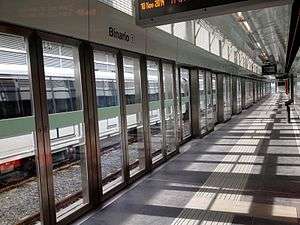
Platform screen doors are used in most newly built rapid transit lines and systems of new construction in Italy. PSDs are present on Turin Metro, the Venice People Mover, the Perugia Minimetrò, the Brescia Metro, Line 5 of the Milan Metro, and Line C of the Rome Metro.
Japan

The Tokyo Metro began using barriers with the 1991 opening of the Namboku Line, and subsequently installed platform edge doors on the Marunouchi and Fukutoshin lines.
In August 2012 the Japanese government announced plans to install barriers at stations used by 100,000 or more people per day, and the Ministry of Land, Infrastructure, Transport and Tourism allotted 36 million yen ($470,800) for research and development of the system the 2011-2012 fiscal year. A difficulty was the fact that some stations are used by different types of trains with different designs, making barrier design a challenge.[14]
As of November 2012, only 34 of 235 stations with over 100,000 users per day were able to implement the plan. The ministry stated that 539 of approximately 9,500 train stations across Japan have barriers. Of the Tokyo Metro stations, 78 of 179 have some type of platform barrier.[15]
South Korea
_002.jpg)
Yongdu Station of Seoul Subway Line 2 was the first station on the Seoul Subway to feature platform screen doors; the station opened in October 2005. By the end of 2009, many of the 289 stations operated by Seoul Metro, Seoul Metropolitan Rapid Transit Corporation (SMRT) by Korean local supplier.[16] SMRT and Seoul Metro Line 9 were equipped with platform screen doors However, not all stations operated by Korail have completed installation. All stations in South Korea will have platform screen doors by 2018.[17] As of 2012, 100%, 57.9%, 49.1%, 41.4% and 15.3% of subway stations are equipped with platform screen doors in Daejeon, Gwangju, Busan, Incheon and Daegu respectively.[18] The platform screen doors installed in Nokdong Station on Gwangju Subway had a unique rope-based platform screen named Rope type Platform Safe Door (RPSD).[19] A set of ropes cordoned off the platform from the rails. When the train arrived, the rope screen ascended to allow entry. This RPSD was removed in 2012, and a new full-height platform screen door was installed in 2016 instead.
Malaysia
Platform screen doors are installed at all underground Kelana Jaya Line LRT stations, from Ampang Park to Masjid Jamek LRT stations for safety reasons. The automated announcement message reading "For safety reasons, please stand behind the yellow line" in both English and Malay languages are also heard before the train arrived at all LRT stations.
Pakistan
In Pakistan, platform screen doors are installed at all stations of bus rapid transits Lahore Metrobus and Rawalpindi-Islamabad Metrobus. There are plans to install them at all stations of Multan Metrobus, Karachi Metrobus and the under construction Lahore Metro.
Russia
Park Pobedy (Russian: Парк Побе́ды) is a station of the Saint Petersburg Metro that was the first station in the world with platform doors. The station was opened in 1961. Later the other nine stations of this type were built in Saint Petersburg (Leningrad): Petrogradskaya (Russian: Петроградская), Vasileostrovskaya (Russian: Василеостровская), Gostiny Dvor (Russian: Гостиный двор), Mayakovskaya (Russian: Маяковская), Ploshchad Alexandra Nevskogo I (Russian: Площадь Александра Невского-1), Moskovskaya (Russian: Московская), Yelizarovskaya (Russian: Елизаровская), Lomonosovskaya (Russian: Ломоносовская), Zvyozdnaya (Russian: Звёздная).
There was an electronic device to ensure that the train stopped with its doors adjacent to the platform doors; they were installed so that driverless trains could eventually be used on the line.[20] Unlike other platform screen doors, which are lightweight units with extensive glazing installed on a normal platform edge, the St Petersburg units give the appearance of a solid wall with heavyweight doorways and solid steel sliding doors, similar to a bank of elevators in a large building, and the train cannot be seen entering from the platform; passengers become familiar with the sound alone to indicate a train arrival.
Singapore
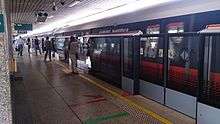
The Singapore Mass Rapid Transit (MRT) was the first rapid transit system in Asia to incorporate platform screen doors in its stations in 1987.[21] Full height PSDs are installed at all existing underground MRT stations in Singapore and all future underground MRT stations. Half-height platform screen doors have been retrofitted into all stations on 14 March 2012 (starting with three elevated MRT stations by 2009), as well as all future elevated MRT stations. The LRT Station at Sengkang also has platform screen panels installed.
There are two series of the full-height platform screen doors in use. The first was installed at all underground stations along the North South Line and the East West Line from 1987 to the completion of the initial system in 1990. The second series of PSDs sporting a sleeker design, producing less sound when the doors were opened and closed, and incorporating more glass were installed in the Changi Airport MRT Station which opened in 2002. All stations in the fully underground North East Line, which opened in 2003, sport these new doors. The Circle Line features second-generation platform screen doors on all of its stations. They were installed on the North South Line platform in the Bishan MRT Station in 2009 after the opening of the Circle line platforms there.
Considered a novelty at the time of its installation, it was introduced primarily to minimise hefty air-conditioning costs, especially since elevated stations are not air-conditioned and are much more economical to run in comparison. Since then the safety aspects of these doors have become more important, as highlighted by a series of high-profile incidents where individuals were injured or killed by oncoming trains since the year 2002 — all occurring on elevated stations with no screen doors. The Land Transport Authority reports that there have been more than 220 cases of commuters trespassing on the tracks between 1991 and 15 September 2004, of which 87 percent were deliberate acts of trespass. Nine fatalities were recorded during this period, of which only one was an accident. Since September 2004 there have been six fatalities occurring on elevated MRT and LRT stations.
The LRT Stations were going to have Platform Barriers as of 24 November 2015 which will be installed at all remaining 42 LRT stations and these platform barriers will not have platform screen doors, as not many people fall to the track on LRT platforms. And these will be completed by 2017/2018. And they already installed at Choa Chu Kang MRT/LRT Station and Bukit Panjang MRT/LRT Station.
Spain

Half platform screens were installed first in Provença FGC station (Barcelona) around 2003. Later doors were tested on Barcelona Metro line 11 before fitting them on all stations for the new lines 9 and 10, which operate driverless. In the Seville Metro this system is the one used since it was opened in April 2009.
Sweden
Stockholm commuter rail will have platform doors in two underground stations which open in 2017. The Stockholm Subway will receive platform doors in two stations on the red line during 2017 - 2018.[22] The underground Liseberg station in Gothenburg has platform doors which were built before its opening 1993. The reason was safety against the freight trains that go in this tunnel. These doors are built one meter from the platform edge and do not restrict the train type.
Switzerland
Zurich International Airport's Skymetro shuttle between the main building (hosting terminals A and B) and the detached terminal E has glass screen doors separating the tracks from the passenger hall platforms at both ends.
Lausanne Metro's Line M2 has glass screen doors at every station.
Taiwan
Platform screen doors and automatic platform gates were both installed from the beginning with the opening of the then Muzha Line (now the Wenshan line, the first metro line in Taiwan) of the Taipei Metro in 1996. In the 21st century, all platforms on the Neihu Line were equipped with them, and since the 2010s, all newly opened stations have been equipped with them. Future extensions and lines will also be equipped with these doors. The last station to come on line without platform screen doors was Nangang Station. TRTC has also decided that they will install platform screen doors in all stations without such doors when they were built and those stations with high amounts of passenger or that are transfer stations will be targeted first. Platform gates in major stations like Taipei Main Station and Yuanshan Station are already in use.
Taipei Metro Stations with platform screen doors:
- Line 1: All Stations
- Line 2: Daan Station to Xiangshan Station
- Line 3: Beimen Station to Songshan Station
- Line 4: Dongmen Station to Huilong Station/Luzhou Station
- Line 5: Dingpu Station and Taipei Nangang Exhibition Center Station
All underground stations on the Kaohsiung MRT system have platform screen doors installed.
Thailand
Bangkok's MRT is equipped with platform screen doors. In 2013, Half platform screens were installed on the BTS skytrain at Siam station and are being installed in several busy stations.
United Arab Emirates
Automatic platform gates are used in all the platforms in the fully automated Dubai Metro, as well as in the Dubai Tram (the world's first tram system to feature platform gates).
United Kingdom

The Jubilee line extension project saw platform screen doors installed on its new stations that were underground. Contrary to in other systems, where PSDs are installed primarily for safety reasons, the Jubilee line PSDs were designed primarily to reduce the movement of air caused by emergency ventilation fans. As a secondary function, they also act a barrier to prevent people falling on to the tracks. The Jubilee line PSDs were produced by Westinghouse.[23] There are no plans to install PSDs in existing London Underground stations.
PEDs are present on the Gatwick Airport shuttle system and on the Heathrow Airport Terminal 5 airside people mover shuttle. In these two cases the purpose is safety as there is a considerable drop on the other side of the doors.
Crossrail will have Platform Edge Doors at most of its underground stations[24] except for at the Heathrow Airport stations. These stations will also be served by Heathrow Express trains, which have a different door layout.
United States

Platform screen doors are generally rare in the United States, and are almost exclusively found on small-scale systems.
In New York City, the Port Authority of New York and New Jersey uses full height platform screen doors at its AirTrain JFK and AirTrain Newark stations. The Metropolitan Transportation Authority has not committed to installing platform screen doors in its subway system. Possible locations for platform doors include several stations along the Second Avenue Subway, but their installation presents substantial technical challenges, as there are different placements of doors on New York City Subway rolling stock.[25][26] The MTA is also interested in retrofitting platform screen doors on the Canarsie Line, along the L train, and on the IRT Flushing Line, along the 7 <7> trains. However, it is unlikely that the entire New York City Subway system will get retrofitted with platform screen doors or automatic platform gates[27] due to, again, the varying placements of doors on rolling stock.[28] Following a series of incidents during one week in November 2016, in which 3 people were injured or killed after being pushed into tracks, the MTA started to consider installing platform edge doors for the 42nd Street Shuttle.[29]
People movers, systems that ferry passengers across large distances they would otherwise walk, make use of platform screen doors. These systems are common at airports such as Hartsfield–Jackson Atlanta International Airport and Denver International Airport. San Francisco International Airport has AirTrain which operates 24 hours a day and is a 6-mile long line that operates between the domestic terminal, international terminal, both international garages, and rental car. Each station is fully enclosed with platform screen doors allowing access to the fully automated People mover. Chicago O'Hare International Airport has a people mover system which operates 24 hours a day and is a 2.5 mile long (4 km) line that operates between the four terminals at the airport and parking areas. Each station is fully enclosed with platform screen doors allowing access to the fully automated people mover trains. AeroTrain is a 3.78-mile (6.08 km) people mover system at Washington Dulles International Airport in Dulles, Virginia with fully enclosed tracks including platform screen doors. The United States Capitol subway system, a train cart people mover system, uses platform gates.
The privately operated Las Vegas Monorail system is currently the only general-purpose rapid transit system in the US to use platform screen doors. Honolulu Rail Transit will become the first large-scale publicly run metro system in the United States to feature platform screen doors when it opens in late 2020.[30]
Incidents
On 15 July 2007 in Shanghai, platform-edge doors led to a fatal accident. A man tried to force his way onto a crowded train at the station for the Shanghai Indoor Stadium but failed. When the doors closed, he was sandwiched between the two sets of closed doors. Unable to retreat to the platform due to the closed screen doors behind him, he was pulled under the train, leading to his death.[31]
On 6 November 2014, 33-year-old passenger Pan Xiaomei was killed when she tried to board the train at Huixinxijie Nankou Station on Beijing Subway's Line 5. She was attempting to board a train in the midst of an extremely dense mass of passengers, and found herself trapped between the train and the platform screen doors which had closed behind her. The train pulled away from the station several seconds later, crushing her to death. This was the third death linked to subway platform doors in China within the several years preceding it.[32][33]
Transport for London reports that the London Underground's platform screen doors have led to multiple incidents where passengers and staff were injured. Multiple passengers reported that PSDs at several stations struck them in the head and arms. Between 1999 and 2012, there were 75 injuries incurred by London Underground PSDs.[34]
References
- 1 2 http://www.mic-ro.com/metro/platform-screen-doors.html
- ↑ North West Rail Link - Homepage
- ↑ , São Paulo Metro Official website Archived 17 May 2008 at the Wayback Machine.
- ↑ "LCQ16: Retrofitting of PSDs at MTR stations to be completed by 2006". HKSAR Government Information Centre. 5 January 2005. Retrieved 17 June 2007.
- ↑ Law, C.K.; Yip, P.S.F. (30 January 2011). "An economic evaluation of setting up physical barriers in railway stations for preventing railway injury: evidence from Hong Kong". Journal of Epidemiology and Community Health. 65: 915–920.
- ↑ "東鐵不裝幕門被轟為慳錢" (in Chinese). Apple Daily. 4 July 2005.
- ↑ "Contracts". Sha Tin to Central Link. MTR Corporation. Archived from the original on 4 March 2016. Retrieved 23 November 2015.
- ↑ "WPSD Platform Screen Door System - Case Study". Platformscreendoors.com. Archived from the original on 26 June 2008. Retrieved 1 August 2009.
- ↑ "Vuosaari platform doors introduced on 15 February". HKL. 17 February 2012. Retrieved 20 March 2012.
- ↑ "Media Kit - Airport Express". Reliance Airport Express Metro. Archived from the original on 29 August 2011. Retrieved 9 November 2011.
- ↑ "Delhi Metro to have driver less trains".
- ↑ "Metro to get platform screen doors". Times of India. 5 January 2011. Retrieved 9 November 2011.
- ↑ "Delhi Metro to get Platform screen doors".
- ↑ Asahi Shimbun Keeping commuters safe; mobile station barriers October 20, 2011
- ↑ Daily Yomiuri Progress stalls on installing platform barriers at train stations nationwide November 13, 2012
- ↑ 행복미소 장지역 | [5678 NEWS] 제4회 부산국제철도 및 물류산업전(RailLog Korea 2009 - Daum 카페
- ↑ 잇단 투신에도…국철 스크린도어 설치는 '서행' Hankooki.com (in Korean) Archived 14 January 2013 at the Wayback Machine.
- ↑ 문병호 의원, 기존 전철역에도 스크린도어 설치 국비지원을 스크린도어 설치로 인한 자살예방 효과 탁월 Asia News Agency (in Korean)
- ↑ Rope type Platform Safe Door English promotional
- ↑ Cooke, B.W.C., ed. (November 1959). "Sliding Doors on Platform Edge". The Railway Magazine. Westminster: Tothill Press. 105 (703): 796.
- ↑ Westinghouse Platform Screen Doors - Completed Projects Archived 13 February 2008 at the Wayback Machine.
- ↑ http://www.sll.se/Global/Politik/Politiska-organ/Trafiknamnden/2016/23%20augusti%202016/p27-SL-2016-0044-Tjut-plattformsbarriarer.pdf
- ↑ "Westinghouse Platform Screen Doors". Platformscreendoors.com. Retrieved 1 August 2009.
- ↑ "Crossrail's platform screen doors will be built in the UK". Railway Technology Magazine. Retrieved 21 September 2015.
- ↑ NYC Subway Deaths Spur Officials to Call for Action Archived 5 November 2013 at the Wayback Machine., The Epoch Times.
- ↑ CUSTOMER CONTACT WITH TRAIN INCIDENT REPORT, January 2013.
- ↑ Capital New York: After subway-push killings (and Lhota's resignation), the MTA considers platform screen doors
- ↑ Council demands an end to the M.T.A.‘s subway-safety ’exploratory' phase Archived 23 March 2014 at the Wayback Machine.
- ↑ Furfaro, Danielle (2016-11-15). "MTA boss makes another push for subway platform doors". New York Post. Retrieved 2016-11-16.
- ↑ Honolulu Rail Project - Ansaldo STS
- ↑ "Man caught between subway train and safety doors dies in Shanghai". International Herald Tribune. 29 March 2009. Archived from the original on 18 August 2007. Retrieved 1 August 2009.
- ↑ "South China Morning Post - Beijing subway passengers tried to raise alarm before accident victim was dragged to her death"
- ↑ Passenger crushed to death while trying to board subway train in Beijing-Sino-US
- ↑ "HTML version of an attachment to the Freedom of Information request 'Safety of platform screen doors'". WhatDoTheyKnow. Retrieved 2016-10-24.
External links
| Wikimedia Commons has media related to Train station platform screen doors. |
- Platform screen doors Metro Bits